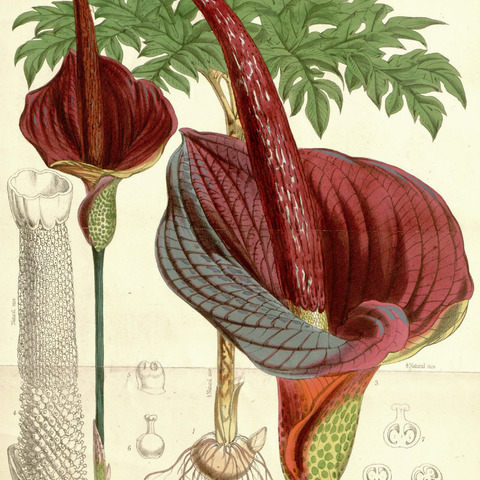Tuber brown, slightly glossy, depressed globose, to ca. 20 cm high, to ca. 30 cm in diam., seasonally producing numerous long rhizomatous offsets with swollen apical part, these to ca. 50 × 3 cm. Leaf solitary; petiole background color dirty whitish pinkish or dirty cream-colored, often nearly entirely covered by large, elongate, dark green confluent spots and smaller white dots, or with numerous small, blackish green spots, very variable, to ca. 100 × 8 cm, glabrous or with scattered punctiform warts at base; leaf blade highly dissected, to ca. 200 cm in diam., rachises narrowly winged; leaflets dull green adaxially, elliptic, 3-10 × 2-6 cm, acuminate. Inflorescence long pedunculate (rarely short); peduncle colored as petiole, to ca. 110 × 5 cm. Spathe outside base dirty pale brownish with blackish green spots, or dirty pale whitish grayish with a few scattered blackish green dots, near margin flushed with purple; inside base maroon with or without a paler whitish purplish zone above, elliptic-lanceolate to broadly ovate-triangular, 10-60 × 10-55 cm, base and limb ± separated by a shallow constriction, margin ± strongly sinuous, apex acute; base within densely verrucate, verrucae tiny, punctiform; limb erect, outside uniformly dark purplish brown, or with scattered blackish green spots, inside uniformly dark brown, glossy, undulate and/or longitudinally folded, basal margin spreading. Spadix during female anthesis producing a strong smell of rotting meat and producing small, clear, slightly viscous droplets, sessile, 15-110 cm; female zone cylindric or narrowly conic, 2-11 cm, 1-4 cm in diam. at base and to ca. 6 cm in diam. at apex, flowers congested or distant; ovary whitish or pale pinkish, apex purplish, depressed globose, oval or suborbicular in cross section, 2-2.5 mm high, 2-4 mm in diam., 2-or 3-loculed; style purplish, 1-5 mm, ± slender, 0.7-1 mm in diam., often distinctly branched at apex; stigma dirty yellowish brown, depressed, strongly undulate, often sunk between enlarged style branches, 2-or 3(or 4)-lobed, oval or triangular in cross section, ca. 0.5 mm high, 1.5-2 mm in diam., verruculose-scabrous; transitional zone between female and male zones occasionally with partly staminodal male flowers and/or pistillodial female flowers or flowers showing all intermediate stages; male zone cylindric, slightly fusiform, or slightly obconic, 2-12 × 1-6 cm, flowers congested; male flowers consisting of 3-5 stamens; stamens 2-2.5 mm; filaments pale orangish yellow or whitish, 0.5-1 mm, basally or entirely connate or slightly diverging at apex; anthers dirty whitish grayish, or ± cream-colored, truncate or subtruncate, 1-1.5 × 0.8-2 mm, rectangular in cross section; connective purplish, turning grayish at anthesis, slightly raised; pores apical, oval or reniform; appendix narrowly fusiform-conic, often laterally compressed and with irregular, shallow longitudinal furrows, 10-85 × 1.5-6 cm, acute, dark purplish brown or paler, densely rugulose, base often with several diamond-shaped, flattened staminodes. Fl. Apr.
More
A large herb which keeps growing from year to year. The tuber is round and 30 cm across. It produces long rhizomes off the side. These are 50 cm long by 3 cm thick. There is a single leaf. The leaf stalk is smooth and dull pink. It is 1 m long. It has dark green and white spots. The leaf blade is very divided. The blade can be 2 m across. The leaflets are pointed and 3-10 cm long by 2.6 cm wide. The flower stalk can be 1.1 m long and coloured like the leaf stalk. The bract around the flower is broadly triangular and funnel shaped. It is 10-60 cm long and 10-55 cm across. It has a wavy edge. The outer surface is dull and brown-green. with darker green spots. It is red-brown inside. The flower spike is like a narrow cone and 0.15-1.1 m long. It can give off a smell like rotten meat for a few days.

